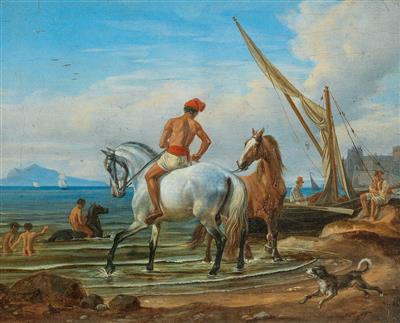Johann Adam Klein

(Nuremberg 1792–1875 Munich)
Naples, the horses’ bath, signed, dated J. A. Klein 1821, oil on panel, 16 x 20 cm, framed, (Rei)
Provenance:
Private Collection Germany.
Compare:
Friedrich von Boetticher, Malerwerke des 19. Jahrhunderts, Hofheim am Taunus 1979, vol. I.2 p. 721, no. 26.;
Johann Adam Klein: handschriftliche Autobiographie aus dem Jahr 1833, in: Romantische Entdeckungen. Johann Adam Klein (1792–1875), Gemälde, Zeichnungen, Druckgraphik, ed. by Jutta Tschoeke, exh. cat. Museen der Stadt Nürnberg, Nuremberg 2006, pp. 314–322.;
Mathias Mende: Italien lockt!, in: Nuremberg exh. cat. 2006, pp. 53–60.
Johann Adam Klein’s great strength lay in depicting animals, especially horses of different breeds and in a variety of situations. The artist, who was born in Nuremberg, initially trained in his home town under the copper engraver Ambrosius Gabler, but he opted to study at the Academy in Vienna from 1811 onwards. During the Napoleonic Wars, he was fascinated by the soldiers and their uniforms, horses and carts.
From 1816 onwards, he undertook study trips to the Alps, near Salzburg, and Berchtesgadener Land, together with Johann Christoph Erhard and Heinrich Reinhold. Klein is primarily known for his extensive oeuvre of prints, but from 1816/17 onwards he also began to work within the medium of oil painting. In 1819, Klein followed his friends Erhard and Reinhold to Rome, where they quickly integrated themselves into the German-speaking artistic scene there. In contrast to Reinhold and Erhard, Klein was able to draw on some savings from previous years during his stay in Italy and thus had no financial worries whatsoever.
As Klein emphasises several times in his autobiography, he never left the house without a sketchbook, “which, as was my habit, always had to be in my pocket.” In 1833, he proudly states that he had already collected 52 sketchbooks on his study trips (quoted from the exhibition cat. Nuremberg 2006, p. 322).
It can be assumed that the motif of the horses’ bath in Naples also originates from this reserve of drawings, and goes back to a trip to Naples that he made in the summer of 1820. The painter Franz Ludwig Catel and the sculptors Johann Nepomuk Haller and Rudolf Schadow (the brother of Friedrich Wilhelm Schadow) were also involved in this venture.
In his autobiography, which Klein wrote more than a decade later on the occasion of his admission to the Royal Academy in Berlin in 1833, he provides concise reports, enriched with a great deal of detail in terms of places and names, from his numerous study trips through southern Germany, Austria and Italy. He writes the following about his trip to Naples in 1820:
“We left Rome on 29 July and our journey, apart from the heat, was very pleasant and passed without adventure. In Terracina, I walked along the shore of the Mediterranean Sea for the first time, and on the fourth day we saw the smoke emitted from the summit of Vesuvius from Molo di Gaeta. The lively Neapolitan people kept me busy, and I created as many studies as possible in the great heat. I went on excursions to Sorrento, to the islands of Ischia and Procida with my friend Catel, and climbed Vesuvius with Vogel and some other friends on 1 September. At that time, it was throwing out glowing ashes and stones, so we were not allowed to approach the big crater. But we had already swallowed enough smoke and sulphur vapour at the small crater and had felt the ash raining down on us. We arrived back in Naples at midnight and I do not regret having taken part in this very tedious and sometimes dangerous endeavour. Bathing in the sea was also particularly beneficial to my health, and I was always very comfortable! As a result, 2 months passed extremely pleasantly.” (quoted from exhibition cat. Nuremberg 2006, p. 320).
As he himself reports, his time in Italy saw him fascinated, above all, by the hustle and bustle of the peasantry, which he diligently captured in sketches. The present lot, as the signature and inscription J. A. Klein Roma 1821 reveal, probably originated after the journey and was created in his studio in Rome. A very similar motif depicting horses bathing on the beach in Naples can also be found in Friedrich von Bötticher’s Malerwerke des 19. Jahrhunderts (vol. I, 2, p. 721, no. 26). Nevertheless, the motif and the summery, cheerful, southern atmosphere with its radiant blue colouring is a special feature of Klein’s work and allows us, as viewers, to share in his enthusiasm for life on the beach in Naples.
Expert: Mag. Dimitra Reimüller
 Mag. Dimitra Reimüller
Mag. Dimitra Reimüller
+43-1-515 60-355
19c.paintings@dorotheum.at
23.10.2019 - 17:00
- Dosažená cena: **
-
EUR 8.960,-
- Odhadní cena:
-
EUR 8.000,- do EUR 12.000,-
Johann Adam Klein
(Nuremberg 1792–1875 Munich)
Naples, the horses’ bath, signed, dated J. A. Klein 1821, oil on panel, 16 x 20 cm, framed, (Rei)
Provenance:
Private Collection Germany.
Compare:
Friedrich von Boetticher, Malerwerke des 19. Jahrhunderts, Hofheim am Taunus 1979, vol. I.2 p. 721, no. 26.;
Johann Adam Klein: handschriftliche Autobiographie aus dem Jahr 1833, in: Romantische Entdeckungen. Johann Adam Klein (1792–1875), Gemälde, Zeichnungen, Druckgraphik, ed. by Jutta Tschoeke, exh. cat. Museen der Stadt Nürnberg, Nuremberg 2006, pp. 314–322.;
Mathias Mende: Italien lockt!, in: Nuremberg exh. cat. 2006, pp. 53–60.
Johann Adam Klein’s great strength lay in depicting animals, especially horses of different breeds and in a variety of situations. The artist, who was born in Nuremberg, initially trained in his home town under the copper engraver Ambrosius Gabler, but he opted to study at the Academy in Vienna from 1811 onwards. During the Napoleonic Wars, he was fascinated by the soldiers and their uniforms, horses and carts.
From 1816 onwards, he undertook study trips to the Alps, near Salzburg, and Berchtesgadener Land, together with Johann Christoph Erhard and Heinrich Reinhold. Klein is primarily known for his extensive oeuvre of prints, but from 1816/17 onwards he also began to work within the medium of oil painting. In 1819, Klein followed his friends Erhard and Reinhold to Rome, where they quickly integrated themselves into the German-speaking artistic scene there. In contrast to Reinhold and Erhard, Klein was able to draw on some savings from previous years during his stay in Italy and thus had no financial worries whatsoever.
As Klein emphasises several times in his autobiography, he never left the house without a sketchbook, “which, as was my habit, always had to be in my pocket.” In 1833, he proudly states that he had already collected 52 sketchbooks on his study trips (quoted from the exhibition cat. Nuremberg 2006, p. 322).
It can be assumed that the motif of the horses’ bath in Naples also originates from this reserve of drawings, and goes back to a trip to Naples that he made in the summer of 1820. The painter Franz Ludwig Catel and the sculptors Johann Nepomuk Haller and Rudolf Schadow (the brother of Friedrich Wilhelm Schadow) were also involved in this venture.
In his autobiography, which Klein wrote more than a decade later on the occasion of his admission to the Royal Academy in Berlin in 1833, he provides concise reports, enriched with a great deal of detail in terms of places and names, from his numerous study trips through southern Germany, Austria and Italy. He writes the following about his trip to Naples in 1820:
“We left Rome on 29 July and our journey, apart from the heat, was very pleasant and passed without adventure. In Terracina, I walked along the shore of the Mediterranean Sea for the first time, and on the fourth day we saw the smoke emitted from the summit of Vesuvius from Molo di Gaeta. The lively Neapolitan people kept me busy, and I created as many studies as possible in the great heat. I went on excursions to Sorrento, to the islands of Ischia and Procida with my friend Catel, and climbed Vesuvius with Vogel and some other friends on 1 September. At that time, it was throwing out glowing ashes and stones, so we were not allowed to approach the big crater. But we had already swallowed enough smoke and sulphur vapour at the small crater and had felt the ash raining down on us. We arrived back in Naples at midnight and I do not regret having taken part in this very tedious and sometimes dangerous endeavour. Bathing in the sea was also particularly beneficial to my health, and I was always very comfortable! As a result, 2 months passed extremely pleasantly.” (quoted from exhibition cat. Nuremberg 2006, p. 320).
As he himself reports, his time in Italy saw him fascinated, above all, by the hustle and bustle of the peasantry, which he diligently captured in sketches. The present lot, as the signature and inscription J. A. Klein Roma 1821 reveal, probably originated after the journey and was created in his studio in Rome. A very similar motif depicting horses bathing on the beach in Naples can also be found in Friedrich von Bötticher’s Malerwerke des 19. Jahrhunderts (vol. I, 2, p. 721, no. 26). Nevertheless, the motif and the summery, cheerful, southern atmosphere with its radiant blue colouring is a special feature of Klein’s work and allows us, as viewers, to share in his enthusiasm for life on the beach in Naples.
Expert: Mag. Dimitra Reimüller
 Mag. Dimitra Reimüller
Mag. Dimitra Reimüller
+43-1-515 60-355
19c.paintings@dorotheum.at
|
Horká linka kupujících
Po-Pá: 10.00 - 17.00
kundendienst@dorotheum.at +43 1 515 60 200 |
| Aukce: | Obrazy 19. století |
| Typ aukce: | Salónní aukce |
| Datum: | 23.10.2019 - 17:00 |
| Místo konání aukce: | Wien | Palais Dorotheum |
| Prohlídka: | 12.10. - 23.10.2019 |
** Kupní cena vč. poplatku kupujícího a DPH
Není již možné podávat příkazy ke koupi přes internet. Aukce se právě připravuje resp. byla již uskutečněna.
Všechny objekty umělce
